Translate this page into:
Isolated cutaneous involvement in a child with nodal anaplastic large cell lymphoma
2 Department of Pathology, Lady Hardinge Medical College, New Delhi, India
Correspondence Address:
Shiwangi Rana
Department of Dermatology, Lady Hardinge Medical College, New Delhi - 110 001
India
| How to cite this article: Mendiratta V, Gandhi N, Rana S, Shukla S, R. Isolated cutaneous involvement in a child with nodal anaplastic large cell lymphoma. Indian J Dermatol Venereol Leprol 2016;82:53-56 |
Abstract
Non-Hodgkin lymphoma is a common childhood T-cell and B-cell neoplasm that originates primarily from lymphoid tissue. Cutaneous involvement can be in the form of a primary extranodal lymphoma, or secondary to metastasis from a non-cutaneous location. The latter is uncommon, and isolated cutaneous involvement is rarely reported. We report a case of isolated secondary cutaneous involvement from nodal anaplastic large cell lymphoma (CD30 + and ALK +) in a 7-year-old boy who was on chemotherapy. This case is reported for its unusual clinical presentation as an acute febrile, generalized papulonodular eruption that mimicked deep fungal infection, with the absence of other foci of systemic metastasis.Introduction
Non-Hodgkin lymphoma is a group of T-cell and B-cell neoplasms that originate primarily from lymphoid tissue and extranodal sites, including the skin. These lymphomas account for approximately 60% of all lymphomas in children.[1] Immunosuppression caused by Epstein–Barr virus infection, human T-cell lymphoma virus, or human immunodeficiency virus increases the risk of developing the disease.[2] Cutaneous manifestations of non-Hodgkin lymphoma are uncommon and can occur in 3.7% of cases.[3] They can be secondary to opportunistic infections, or non-infective dermatoses including icthyosis, erythroderma, maculopapular eruptions, psoriasiform plaques and nodules. Cutaneous deposits of the primary lymphoma can present as nodular eruptions.
Case Report
A 7-year-old boy suffering from non-Hodgkin lymphoma (anaplastic large cell type) involving the cervical lymph node presented OPD with a generalized papulo-nodular eruption and fever for six days. He had received two pulses of cyclophosphamide, hydroxydaunorubicin, oncovin and prednisolone (CHOP) regimen in the past, and was receiving antitubercular therapy for disseminated tuberculosis.
Cutaneous examination revealed multiple, discrete, succulent, erythematous to violaceous papules (0.5 × 0.5 cm) interspersed with a few nodules (0.5 × 1.5 cm) scattered over the limbs, trunk, face and scalp [Figure - 1]. Some lesions showed central umblication, crusting and erosions [Figure - 2], which prompted us to include the differential diagnoses of cryptococcosis, histoplasmosis and atypical varicella. The child was conscious and oriented. Laboratory investigations revealed a low total leukocyte count (3200 cells/mm 3), raised ESR (42 mm/h) and positive C-reactive protein. The patient tested negative for human immunodeficiency virus infection. Other routine hematological and biochemical investigations, blood culture, typhidot and rapid malaria antigen test were negative. Crushed tissue stain with India ink was negative. A skin biopsy was sent for histopathology, fungal stains and mycological culture. Histopathology showed evidence of cutaneous metastasis [Figure - 3] and [Figure - 4] with positive staining for CD30 (uniform intense membranous positivity with accentuation in the golgi area in >90% tumor cells) [Figure - 5] and [Figure - 6], CD3, CD5 [Figure - 7], epithelial membrane antigen markers, anaplastic lymphoma kinase [Figure - 8] and negative staining for CD15 and CD20. A thorough search for systemic involvement (radiography of chest, bone marrow aspiration, ultrasonography abdomen, cerebrospinal fluid examination and magnetic resonance imaging of head) did not reveal other foci of involvement.
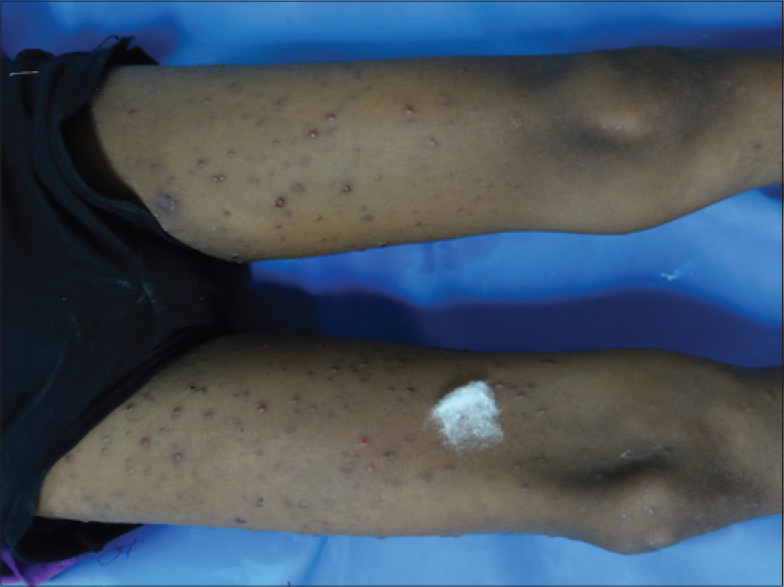 |
| Figure 1: Generalized papulonodular eruption involving both lower limbs |
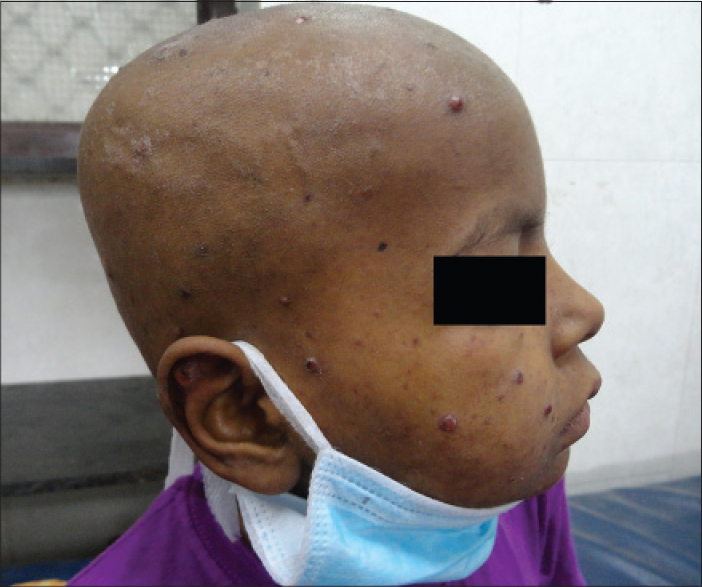 |
| Figure 2: Scalp eruption with central crusting at places |
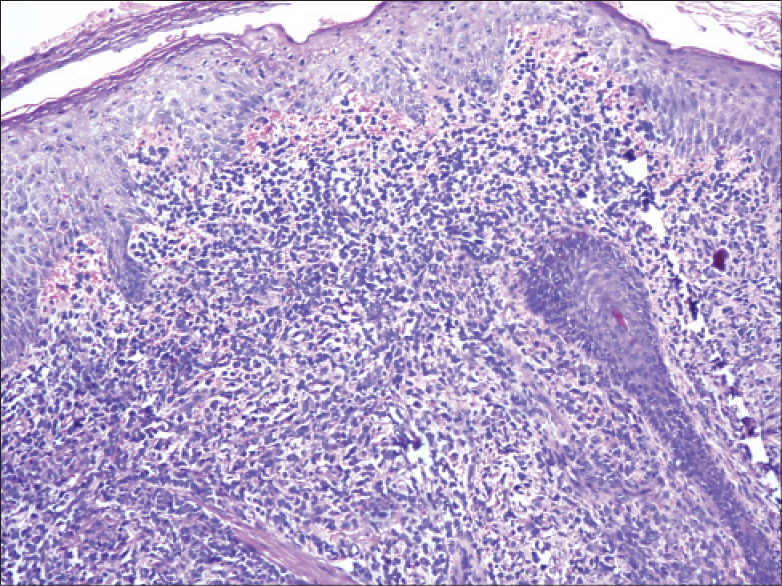 |
| Figure 3: Biopsy from a nodular lesion showing infiltration of atypical lymphoid cells, extending from dermis up to epidermis with no epidermotropism (H and E, ×100) |
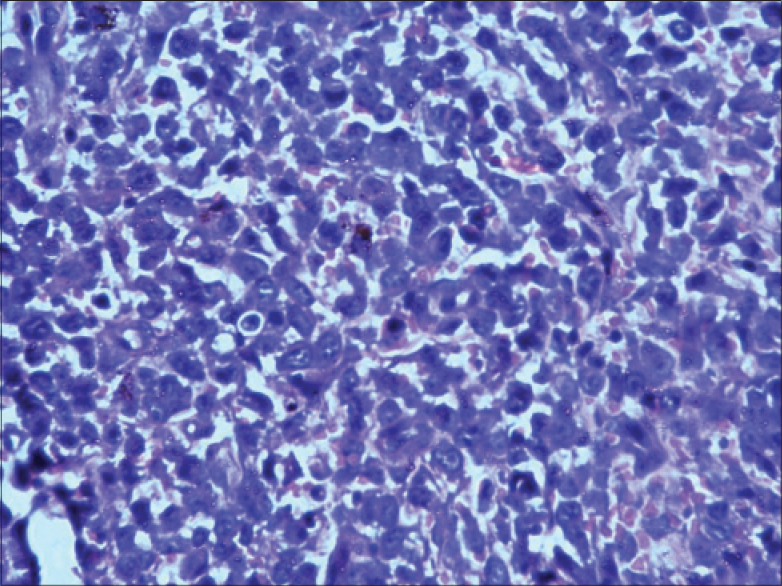 |
| Figure 4: Atypical lymphoid cells of variable size with increased nuclear: cytoplasmic ratio and indentation of nuclei (H and E, ×400) |
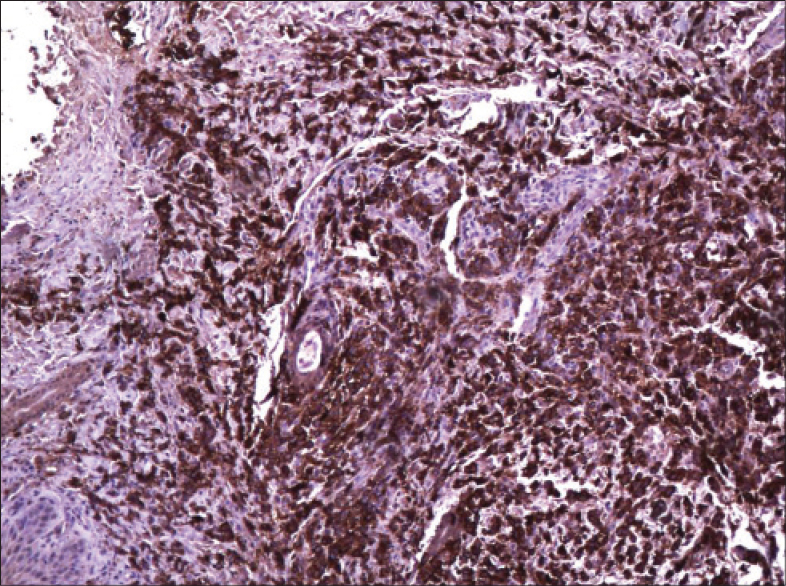 |
| Figure 5: Immunohistochemical staining with CD 30 showing positivity in more than 90% of tumor cells (×100) |
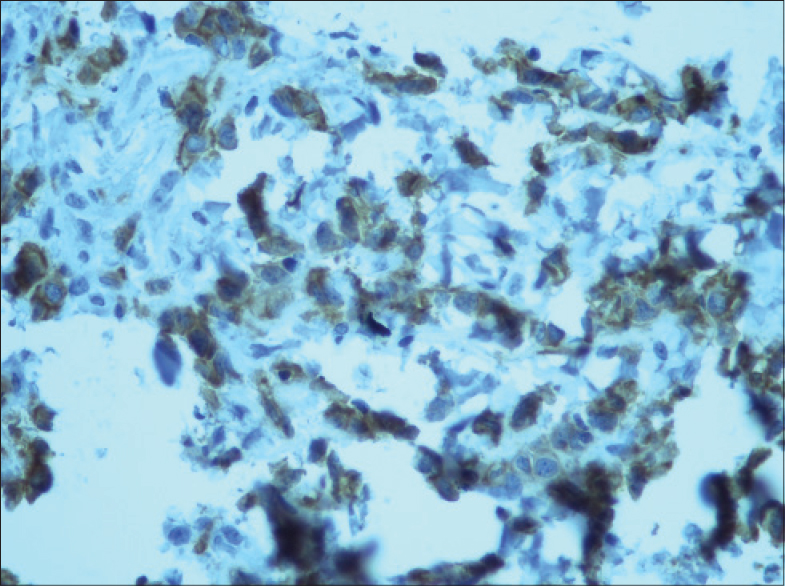 |
| Figure 6: CD 30 positive cells showing uniform intense membranous positivity with accentuation in the golgi area of cytoplasm (×400) |
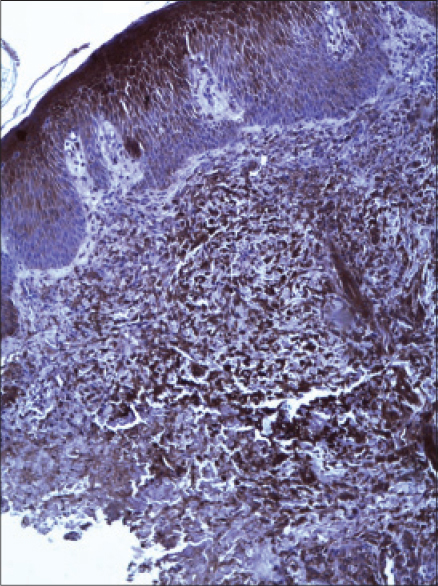 |
| Figure 7: Immunohistochemical stain showing positive staining for CD5 (×100) |
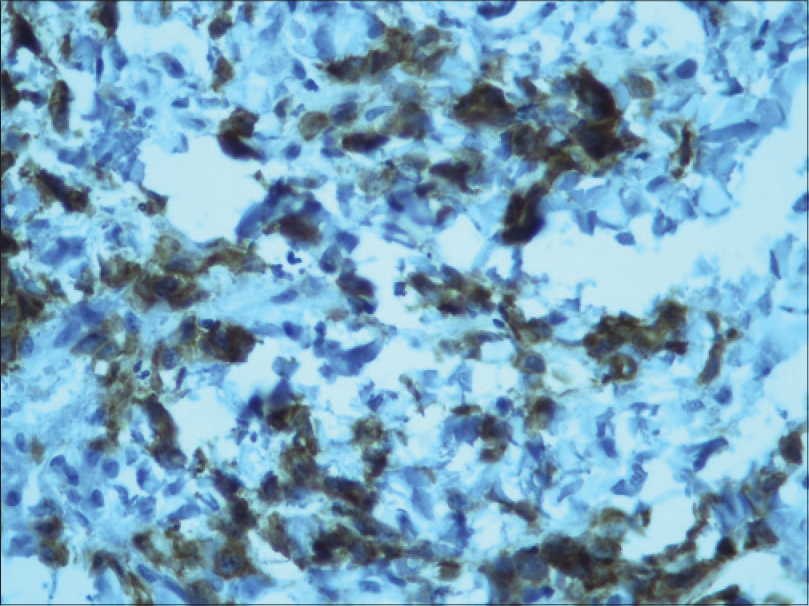 |
| Figure 8: Lymphoid cells in dermis showing strong positivity for anaplastic lymphoma kinase (×400) |
Intravenous amphotericin B was added empirically along with broad spectrum antibiotics (vancomycin, colistin, meropenem and linzolid). However, the spikes of fever continued in spite of treatment. Based upon the clinical and histopathological findings, a diagnosis of post chemotherapy, secondary cutaneous involvement of nodal anaplastic large cell lymphoma (ALK+, CD30+) was made. The child was due for the third chemotherapy cycle of cyclophosphamide, hydroxyduanorubicin, oncovin and prednisolone. It was administered following which complete subsidence of the skin lesions and fever took place within the next few days.
Discussion
Non-Hodgkin lymphoma is broadly classified as precursor B-cell, mature B-cell, precursor T-cell and peripheral T-cell neoplasms, which are further classified into multiple other subtypes. According to the revised European American lymphoma version of the WHO classification of lymphoma, children develop four major histological patterns of non-Hodgkin lymphoma: Burkitt's and atypical Burkitt's lymphoma (40–50%), precursor B-cell or T-cell lymphoblastic lymphoma (30%), diffuse large B-cell lymphoma (15%) and anaplastic large cell lymphoma (10%). Cutaneous involvement of non-Hodgkin lymphoma in children represents primary cutaneous lymphoma or a secondary manifestation of extracutaneous disease. Among all subtypes of non-Hodgkin lymphoma, primary cutaneous origin is seen more commonly with anaplastic large cell lymphoma (10%).[1],[4]
Non-Hodgkin lymphoma is known to involve the central nervous system, bone marrow, liver, mediastinum and lung. The skin is a less frequent site for involvement. The overall incidence of skin involvement (both primary and secondary) was reported to be 18.8% by Kumar et al.[3] and 13.9% by Epstein and MacEachern.[5] The estimated cutaneous involvement in children suffering from non-Hodgkin lymphoma is even lower (1%).[6] Non-Hodgkin lymphoma can have several cutaneous manifestations that are specific or non-specific. Papular, nodular, ulcerative, maculopapular, soft subcutaneous nodules or tumors, generalized icthyosis, psoriasiform eruptions, erythroderma and monomorphic papular lesions have been described.[7],[8] Secondary cutaneous involvement from extracutaneous non-Hodgkin lymphoma or primary cutaneous non-Hodgkin lymphoma may occur as papular, hyperemic, firm or nodular eruptions.[6]
Our patient was a diagnosed case of nodal non-Hodgkin lymphoma (anaplastic large cell type) in the cervical lymph node and later developed a sudden onset of papulonodular lesions with fever. The etiology of papulonodular lesions can be diverse in the presence of an underlying non-Hodgkin lymphoma. As the child was seronegative for HIV and had already received two pulse of chemotherapy, the presence of cutaneous involvement was considered unlikely. Besides, the clinical presentation was suggestive of an opportunistic deep fungal or viral infection, and the risk of fungal infections is higher in hematological malignancies including non-Hodgkin lymphoma.[9] The rapid appearance of lesions and associated constitutional symptoms is unusual and rare.
We are able to find only a few previous reports of secondary cutaneous involvement of non-Hodgkin lymphoma in children.[3],[10] In most of the cases, involvement of to other organs is already present prior to cutaneous involvement. Our case had isolated secondary cutaneous involvement without any other systemic involvement, which is quite rare. Secondary cutaneous metastasis of non-Hodgkin lymphoma carry a poorer prognosis compared to primary cutaneous non-Hodgkin lymphoma,[3],[11] and tends to have an increased risk of treatment failure.
Declaration of patient consent
The authors certify that they have obtained all appropriate patient consent forms. In the form the patient(s) has/have given his/her/their consent for his/her/their images and other clinical information to be reported in the journal. The patients understand that their names and initials will not be published and due efforts will be made to conceal their identity, but anonymity cannot be guaranteed.
Financial support and sponsorship
Nil.
Conflicts of interest
There are no conflicts of interest.
| 1. |
Kliegman. Nelson textbook of paediatrics. In: Waxman IM, editor. 19th ed. Non Hodgkin Lymphoma: Elsevier, Inc; 2012.
[Google Scholar]
|
| 2. |
Corti M, Carolis LD, Solari R, Villafañe MF, Schtirbu R, Lewi D, et al. Non Hodgkin's lymphoma with cutaneous involvement in AIDS patients: Report of five cases and review of the literature. Braz J Infect Dis 2010;14:81-5.
[Google Scholar]
|
| 3. |
Kumar SS, Kuruvilla M, Pai GS, Dinesh M. Cutaneous manifestations of non-Hodgkin's lymphoma. Indian J Dermatol Venereol Leprol 2003;69:12-5.
[Google Scholar]
|
| 4. |
Tomaszewski MM, Moad JC, Lupton GP. Primary cutaneous Ki-1 (CD30) positive anaplastic large cell lymphoma in childhood. J Am Acad Dermatol 1999;40:857-61.
[Google Scholar]
|
| 5. |
Epstein E, MacEachern K. Dermatological manifestations of the lymphoblastoma-leukemia group. Arch Intern Med 1937;60:867.
[Google Scholar]
|
| 6. |
Buyukpamukcu M, Ilhan I, Caglar M Akyüz C, Berberoğlu S, Kotiloğlu E. Skin involvement in children with non-Hodgkin's lymphoma. Turk J Pediatr 1995;37:117-23.
[Google Scholar]
|
| 7. |
Maio P, Bento D, Vieira R, Afonso A, Sachse F, Kutzner H. Non Hodgkin T cell lymphoma: An atypical clinical presentation. An Bras Dermatol 2013;88:264-7.
[Google Scholar]
|
| 8. |
Reich A, Wróbel G, Kazanowska B, Maldyk J, Bubala H, Dluzniewska A, et al. Skin involvement in highly malignant non-Hodgkin lymphomas of childhood and adolescence. Acta Dermatoven APA 2006;15:158-69.
[Google Scholar]
|
| 9. |
Pagano L, Caira M, Candoni A, Offidani M, Fianchi L, Martino B, et al. The epidemiology of fungal infections in patients with hematologic malignancies the SEIFEM-2004 study. Haematologica 2006;91:1068-75.
[Google Scholar]
|
| 10. |
Padhi S, Paul TR, Challa S, Prayaga AK, Rajappa S, Raghunadharao D, et al. Primary Extra Nodal Non Hodgkin Lymphoma: A 5 Year Retrospective Analysis, Asian Pacific J Cancer Prev 2012;13:4889-95.
[Google Scholar]
|
| 11. |
Fink-Puches R, Chott A, Ardigó M, Simonitsch I, Ferrara G, Kerl H, et al. The spectrum of cutaneous lymphomas in patients less than 20 years of age. Pediatr Dermatol 2004;21:525-33.
[Google Scholar]
|
Fulltext Views
2,882
PDF downloads
1,890





